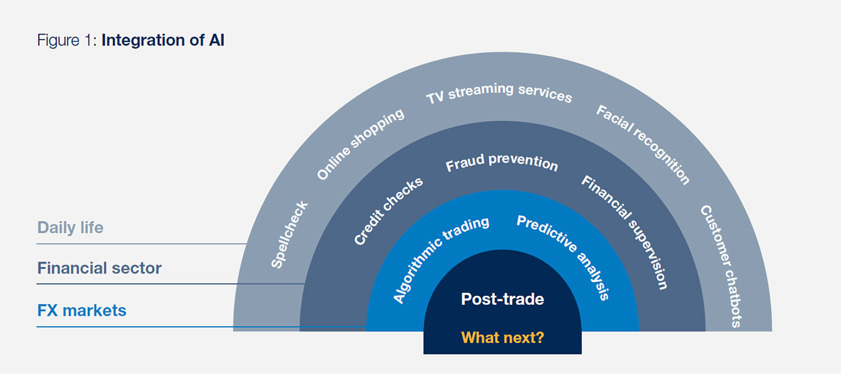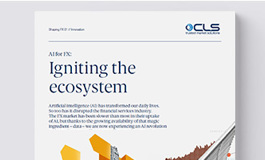Innovation 01 | AI for FX: Igniting the ecosystem | ShapingFX series
Artificial intelligence (AI) has transformed our daily lives. So too has it disrupted the financial services industry. The FX market has been slower than most in their uptake
of AI, but thanks to the growing availability of that magic ingredient – data – we are now experiencing an AI revolution in the trading space. This paper offers insights into AI’s increasing role in the FX market, explains CLS’s involvement in aggregating FX data and considers what comes next.

What, where, when and wh(AI)?
“Artificial intelligence”, or “AI”,1 has become a ubiquitous term in recent years with use cases arising in many facets of life.2 Although often considered nascent technology, particularly in the financial sector, AI’s origins can be traced back over half a century.3
In the early days of computing, AI was more narrowly defined as “the ability of a digital computer or computer-controlled robot to perform tasks commonly associated with intelligent beings.”4 Today, the idea that a machine can learn our habits and adapt to suit our needs is no longer a scary thought but a reality many of us take for granted – from spell check to targeted recommendations on TV streaming platforms and mobile devices. In fact, what was considered AI in the past is now commonplace technology many of us carry in our pockets.5
Over time, AI’s capabilities moved beyond solving simple data analysis tasks to skills such as identifying causes in system behavior and drafting code.6 Generative AI (GenAI) platforms have become increasingly popular. These platforms use deep learning algorithms7 to perform tasks more complex than distinguishing between sets of classifications.8 Instead, they can identify patterns and structures in data to produce their own data, and even their own whitepapers.
One notable development was the launch of ChatGPT in November 2022, a chatbot that provides human-like text responses to natural language user prompts. It was reported in February 2023 that within two months of launch, ChatGPT had amassed one hundred million users, making it the fastest-growing consumer application in history.9
What does ChatGPT know about FX settlement risk?
Putting its skills to the test, we asked the platform a key question at the heart of what we do at CLS: how best to mitigate settlement risk in the FX market. In less than a minute ChatGPT described several key areas of focus for global initiatives, such as greater adoption of PvP settlement and the use of netting.
The AI-generated response proved to be more nuanced than a Google search response, recognizing the difficulties in mitigating settlement risk such as the lack of a simple one-size-fits-all solution: “It’s important to note that while these measures can significantly reduce settlement risk, they may not completely eliminate it. Market participants should carefully evaluate their strategies and choose appropriate risk management techniques.”
(ChatGPT, 2023)
The increasing development of AI for everyday applications already benefits many. However, it is important that new technology be harnessed in a way that recognizes relevant risks so that existing processes and populations can more safely adapt.10
1This article uses the term AI to refer to a subset of computing tools related to artificial intelligence including machine learning, natural language processing and robotics.2Fintech Times (2023), How Will Generative AI Revolutionise Digital Payments in MENA?3AI research dates back to Alan Turing’s work in the first half of the 20th century. britannica.com/technology/artificial-intelligence/Alan-Turing-and-the-beginning-of-AI4Artificial intelligence (AI) | Definition, Examples, Types, Applications, Companies, & Facts | Britannica.
5thecadenceteam.com/the-changing-definition-of-artificial-intelligence/
6Gartner: Emerging tech that will accelerate AI automation | AI Business.7Deep learning algorithms are a method in AI that teaches computers to process data in a way that is inspired by the human brain. See aws.amazon.com/what-is/deep-learning/
8 Discriminative models of AI are built to learn about the boundary between classes within a dataset. Their goal is to identify the decision boundary between these classes. These models can be distinguished from more recent developments in GenAI.
9Forbes (2017), Artificial Intelligence Will Enable 38% Profit Gains By 2035.10The recent growth of technology in the GenAI space has also brought legal and compliance risks that need to be properly identified and mitigated. For example, by inputting data into generative tools, users risk improper disclosure or use of confidential information. There can also be a lack of transparency or fairness in the models and datasets that drive AI models, risking outputs that are biased or factually incorrect, or that contain proprietary content from a third-party source leading to potential intellectual property infringement.
